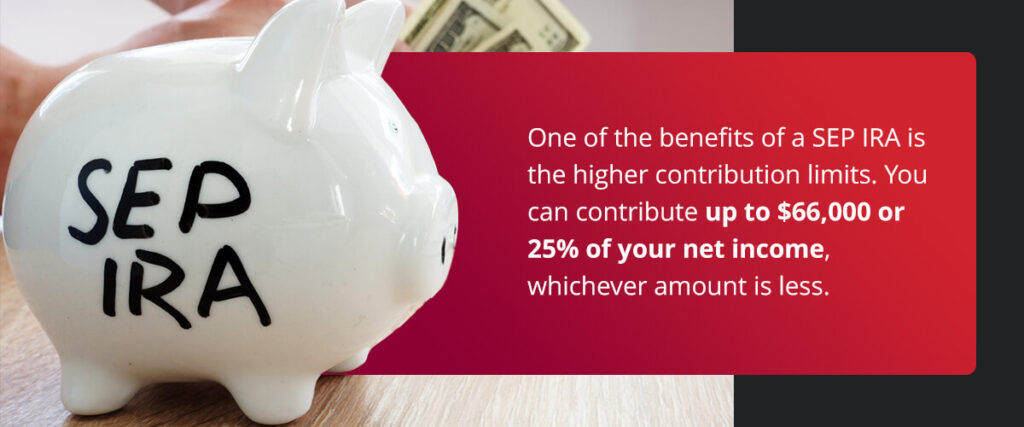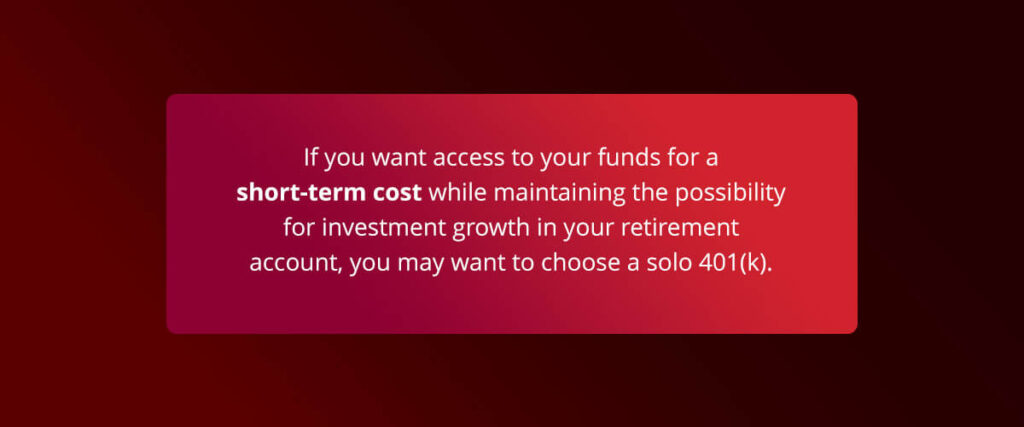
If you are self-employed, you may be wondering how you can plan for retirement. Since you don’t have an employer’s support, you’ll want to explore alternative options that may be available to you. This article covers what makes a retirement plan good for a self-employed individual and some plans that may be ideal for you. We also discuss retirement planning challenges when you’re self-employed and steps you can take to ensure you’re ready for retirement.
What Is a Good Retirement Plan for Self-Employed Individuals?
There are different types of retirement plans for self-employed individuals. Several factors affect which types may be a good fit for you. Here are some things to consider when choosing a retirement plan if you’re self-employed:
- Flexibility: If you’re self-employed, you may experience fluctuations in your income. The ideal retirement plan offers flexibility in contributions, enabling you to contribute more in your high-income years and less during leaner times.
- Scalability: A good retirement plan is scalable and can accommodate business growth. As your business and income change, you should be able to adjust your retirement plan to your changing circumstances and increase your contributions as your income rises.
- Fees and costs: The costs associated with your retirement plan may include administrative fees, custodial fees and investment management fees. With lower costs, you may experience greater long-term returns.
- Tax advantages: Tax-deductible retirement plans for self-employed individuals may offer tax advantages. Your contributions to certain types of retirement plans may be tax-deductible, which can reduce your tax liability. Additionally, you can get tax benefits with a plan offering tax-free withdrawals — such as Roth plans — or tax-free growth during retirement.
- Contribution limits: Ideal retirement savings plans for self-employed individuals also have higher contribution limits, enabling you to save more of your income for retirement. When your plan has a higher contribution limit, you can take advantage of the tax benefits and accrue significant retirement savings over time.
- Catch-up contributions: If you are nearing retirement age, make sure you can make catch-up contributions. Seek a retirement plan that permits additional contributions for individuals aged 50 and above, as these catch-up contributions let you increase your retirement savings rate later in your career.
- Investment options: Additionally, you may want a retirement plan that offers a diverse range of investment options. You should be able to invest in assets that align with your retirement savings goals and risk tolerance. For example, you may want to look for a plan with a wide range of investment vehicles like stocks, bonds, mutual funds and real estate. These alternative assets can create a diverse portfolio and help your savings grow.
- Plan administration: Self-employed individuals are typically responsible for plan administration. The right retirement plan has manageable administrative requirements, simplifying setup and maintenance. Minimizing your administrative burdens can save you time and effort, allowing you to return your focus to your business.
- Employer contributions: If you have employees, you can incentivize employee retention by offering employer contributions to retirement plans. Consider plans that allow employer contributions, remembering to factor in any associated costs and fees.
3 Best Retirement Plans for Individuals
Three ideal retirement plans for self-employed individuals include SEP IRAs, SIMPLE IRAs and solo 401(k) plans.
1. SEP IRA
A Simplified Employee Pension (SEP) IRA is a type of retirement plan best suited to freelancers, sole proprietors and small business owners. Like all plans, a SEP IRA has pros and cons.
The benefits of a SEP IRA include the following:

- Higher contribution limits: One of the benefits of a SEP IRA is the higher contribution limits. You can contribute up to $66,000 or 25% of your net income, whichever amount is less. The contribution amount is based on your income and can change each year depending on your financial situation.
- Simplified setup and administration: When you choose a SEP IRA, setup and maintenance are easy. This retirement plan involves minimal paperwork, and many financial institutions offer a SEP IRA account. When you’re self-employed, you’re considered both employer and employee, simplifying your administrative requirements.
- Tax-deductible contributions: Contributions to your SEP IRA are tax deductible, so you get immediate tax advantages. When you contribute to a SEP IRA, you may be able to lower your annual taxable income, which can reduce your tax liability.
- Flexibility in retirement contributions: Unlike other retirement plans, you are not required to contribute to a SEP IRA each year. You can choose whether you want to contribute and how much to contribute, depending on your financial circumstances. This flexibility is especially beneficial if you have a variable income.
- Employer contributions: When you’re self-employed, you can contribute to your SEP IRA as an employer and an employee. Your employer contributions are deductible as a business expense and based on a percentage of your net individual income. Your contributions to your employees’ plans should be proportional to the employer contributions to your own SEP IRA.
The disadvantages of a SEP IRA include the following:
- Early withdrawal penalties
- Required minimum distributions
- Required employer contributions
- Minimal employee deferral options
- Withdrawals subject to income tax
- Potential to limit eligibility for other retirement plans
2. SIMPLE IRA
As a type of retirement plan, the Savings Incentive Match Plan for Employees (SIMPLE) IRA is intended for small businesses and self-employed individuals with fewer than 100 employees. This retirement plan offers simplicity, fewer administrative requirements and both employer and employee contribution options.
The following are some of the benefits of a SIMPLE IRA for self-employed individuals:
- Straightforward setup and administration: The SIMPLE IRA is easy to set up and administer. Unlike more complicated retirement plans, your administrative responsibilities and costs for a SIMPLE IRA are relatively low.
- Employee and employer contributions: You can contribute to a SIMPLE IRA as both the employer and the employee. You must also make employer contributions to accounts for eligible employees. Employee contributions are made via salary deferrals on a pre-tax basis. Employees can contribute up to $15,500 via salary deferral, while the catch-up contribution limit is $3,500. As the employer, you can make a non-elective contribution of 2% of an eligible employee’s compensation or a matching contribution of up to 3% of their compensation.
- Tax-deductible contributions: Employee and employer contributions to a SIMPLE IRA are tax-deductible. Employee contributions are pre-tax, reducing the employee’s annual taxable income, while employer contributions are deductible as a business expense.
The following are some of the disadvantages of a SIMPLE IRA for self-employed individuals:
- Fewer plan options
- Minimal rollover options
- Lower contribution limits
- Penalties for early withdrawals
- Required minimum distributions
- Required employer contributions
3. Solo 401(k)
The solo 401(k) for self-employed individuals is a type of retirement plan intended specifically for sole proprietors without full-time employees, except for a spouse who is considered an employee. If you’re self-employed, the benefits of a solo 401(k) include the following:

- Option to obtain a loan: Depending on the details of your plan, a solo 401(k) may permit you to obtain a loan using your account balance. If you want access to your funds for a short-term cost while maintaining the possibility for investment growth in your retirement account, you may want to choose a solo 401(k).
- Possible tax benefits: You may gain tax advantages when contributing to a solo 401(k), as pre-tax contributions can lower your annual taxable income.
- Higher contribution limits: Another one of the benefits of a solo 401(k) is its higher contribution limits. You can contribute as much as $66,000, which can allow you to accelerate your retirement savings rate.
- Simple plan administration: Generally, the solo 401(k) is easy to administer. You usually face fewer administrative requirements compared to retirement plans intended for larger businesses.
- Flexibility in investment vehicles: A self-employed 401(k) typically offers a wide range of investment options. Based on your plan’s provisions, you may invest in mutual funds, ETFs, stocks, bonds and real estate. This flexibility allows you to diversify your investment portfolio and align it with your risk tolerance and financial goals.
The disadvantages of a solo 401(k) include:
- Restrictions on plan eligibility
- Required minimum distributions
- Potential for greater costs and fees
- Possible high contribution requirements
Difficulties of Retirement Planning for Self-Employed Individuals
If you are a self-employed individual, retirement planning comes with a few challenges. The following are some of the difficulties you may face when retirement planning:
- Irregular income: When you’re self-employed, you may frequently experience irregular income or fluctuations in your income streams. Unlike employees who earn a predictable income, you may have months with high earnings and periods with little or no income. This irregularity in income can make it challenging to plan and make consistent contributions to your retirement savings.
- Complicated tax considerations: You may also face complex tax considerations when you’re self-employed, as you likely need to pay self-employment taxes and income taxes. Understanding the tax implications of a retirement plan can be difficult — we recommend seeking guidance from tax professionals or financial advisors who can help you maximize your retirement savings and use the best tax strategies.
- Self-discipline and motivation: When you’re self-employed, you don’t have the structure and accountability that comes with an employer-sponsored retirement plan. As a result, you should be disciplined and motivated to contribute consistently to your retirement savings.
- Less access to employer benefits: As a self-employed individual, you may also miss out on receiving employer benefits that may aid in your retirement savings rate. These benefits include employer matching on your contributions and access to group retirement plans that may come with lower fees. As a result, you may need to find other ways to compensate for this lack of support from an employer.
- Limited Social Security contributions: You must pay both the employer and employee portions of Medicare and Social Security taxes. Together, these are called self-employment taxes. Since these contributions are calculated based on your net income, which may be lower than the income of employees with similar earnings. In retirement, this means you may have lower Social Security benefits.
- Minimal time and resources for planning: Finally, you are typically also responsible for every aspect of your business as a self-employed individual, which can leave you with minimal time and resources to allocate to retirement planning. Completing your retirement planning and balancing the demands of operating your business can be difficult, which may lead you to neglect your retirement planning needs.
Steps to Take to Make Sure You’re Set for Retirement
When planning for retirement, carefully consider the steps you can take to ensure financial security in your golden years. Here are some steps you can take to prepare for retirement:

- Estimate your financial needs in retirement: First, you may want to calculate the amount of income you expect to need in retirement to fund your lifestyle. Consider factors like living expenses and activities you want to do during your retirement, such as travel. Remember that you’ll need to account for inflation.
- Develop a plan for your retirement savings: Next, create a plan to save and invest for your retirement. Choose a target savings rate and develop a budget that enables you to save effectively and consistently. Select tax-advantaged retirement accounts like IRAs and 401(k)s, and automate your contributions to your retirement account to ensure you save regularly.
- Manage your expenses and reduce your debt: You may also want to lower and manage your debt as much as possible before retirement. Pay down your high-interest debts, focusing on becoming debt-free. Review your expenses, and pinpoint areas where you can cut back or make changes to free up more funds for your retirement savings.
- Invest strategically for long-term growth: You then want to develop an investment and savings plan that aligns with your risk tolerance and time until you reach retirement age. Diversify your investment portfolio with various asset classes to reduce risk and pursue opportunities for growing your retirement funds, along with regularly reviewing and adjusting your investment allocation as you near retirement to balance potential returns with the potential risks.
- Factor in health care and insurance: Finally, you should understand the health care options available to you in retirement. Consider the costs of health insurance and long-term care insurance. Look for potential gaps in coverage as you do your retirement planning. You’ll also want to research Medicare to determine when and how you can enroll and consider an HSA to help cover your health care costs in retirement.

Schedule a Meeting to Learn More
At Accuplan, we specialize in providing self-directed retirement accounts. We offer custodial services if you want greater control over your retirement savings and investments. You can invest in traditional assets, like stocks and bonds, and alternative assets, such as real estate, private equity and precious metals. As a custodian of your retirement account, we administer the assets on your behalf.
Schedule a meeting with us at Accuplan to learn more about how you can save for retirement as a self-employed individual.
*Our information shouldn’t be relied upon for investment advice but simply for information and educational purposes only. It is not intended to provide, nor should it be relied upon for accounting, legal, tax or investment advice.